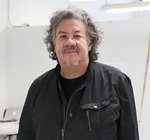February 2022
Restorative aesthetic is a key feature of Greg Staats’s Skarù:reˀ [tuscarora] / Kanien’kehá:ka [mohawk], Hodinöhsö:ni [people of the longhouse] recent work. Staats is a Toronto based artist who practices in photography, performance, video installation, and sculpture. Staats is also the recipient of Toronto Arts Foundation’s inaugural Indigenous Artist Award, created in 2021 to recognize an Indigenous artist or collective who has contributed to arts and culture in Toronto.
 Greg Staats
Greg Staats
The restorative aesthetic that deeply informs his work is an attempt to address systemic deficits experienced by the Hodinöhsö:ni including their original displacement in the late 1700s from the Mohawk Valley in upper New York State to the Grand River Territory as allies to the crown. Other forms of displacement forced by white settler colonialism led to the deprivation of language, culture, and governance. Through his art Staats hopes that “fragments of a culture can be meaningfully strung together in a truly restorative aesthetic that also elevates the mind.”
In putting together often wordless images, themselves showing fragments of a culture, his work connects his own personal trauma, his on-reserve lived experience, and the historical trauma of the Hodinöhsö:ni. Through photographs that are still as they are reflective - showing detail of a moldy corner ceiling, the twisting roots of a tree or a leaning iron cross propped up by a rock marking a Mohawk grave from 1655 along a river - as well as archival materials like newspaper clippings, Staats works out a “language” and creates a process of remembering. This creation of a visual “language” is critical for Staats, given how the slow deprivation of language was an experience of the Hodinöhsö:ni after colonization. The wordless images, as well as the archival artifacts in Staats’s art presents a universal worldview through a connective language of metaphors. For Staats, his work informs his own restoration of identity and deep emotional connection with land, nation, family and self, as he moves towards a “cultural embrace.”
Part of the restorative aesthetic is to realize that not all knowledge is lost, that there still exists an active Longhouse Tradition. As Staats explains, the knowledge is “on the ground, waiting for us to pick it up.”. It is in this regard that the guidance of Alfred Keye has been important for Staats’s work. Keye, Mohawk, is a Longhouse Faith Keeper, Cayuga translator and transcriber, former Native Second Language and Cayuga Immersion Teacher. As part of our Indigenous Artist Award, the recipient is able to designate a professional artist mentor/Elder, who receives $5,000. Staats designated Alfred Keye. Through this designation Staats is acknowledging the incredible work Keye has done for language revitalization, and his efforts to share cultural information with artists like him. Keye’s knowledge of Indigenous language and tradition has also earned him recognition as Indigenous knowledge guardian at Deyohahá:ge: Indigenous Knowledge Centre, Six Nations Polytechnic, 2010. “Alfred is a living document that recites knowledge,” is how Staats describes him.
What brings both Keye and Staats together is their commitment to the preservation of culture. While Keye does that through language, Staats does it through photography, video and sculpture. In his letter of support for Greg Staats’s nomination to the Award, Keye identified how their continued work together ensures that Staats “respectfully adheres to the Hodinǫhsǫ:ni: protocols of traditional knowledge of sensitive materials and cultural intellectual property rights.”
Staats points out that working with Keye allows him to find sources of traditional knowledge. Through their discussions they explore where the original Hodinöhsö:ni ways come from, as well how the culture, gestures, roles, relationships exist today, in actuality, allowing Staats to conceptualize the values, and responsibilities of placemaking relationships within a structure of condolence and thanksgiving.
“It’s about continuing the work of sharing knowledge,” says Staats about the importance of mentorship in his work and for other artists. “We have the responsibility of knowledge to share with other people, with young people on the reserve.”
Greg Staats, portrait of Alfred Keye, 2021.
Image Description: A black and white image of Alfred Keye. He has long white hair that is tied at the back and a short beard.
Greg Staats, FOUND, 2022 archival pigment prints on cotton fibre canvas. Oil. Indian Tobacco ash, earth, 60” x 60” Work in progress.
Image Description: black and white picture of tree roots emerging from the ground.
Greg Staats, dark string, Canada, colour, live video feedback installation 16 inches - 50 piece handmade Quahog purple notification of death wampum string sinew, small white pin, analog DVC video camera, tripod, digital projector collection of National Gallery of Canada and Art Gallery of Ontario https://vimeo.com/user43876356 https://vimeo.com/222401401
Greg Staats, 1969 [Series 9 of 9], 2021. 52 x 40 inches. archival pigment print on cotton fibre paper. edition 1 of 3
Greg Staats, What have you seen along the road, 2019. 50 x 70 inches. archival pigment print on cotton fibre paper. edition 1 of 3
Image Description: Shadows of a group of people. There are images of tin shacks within some of these black figures.
Image Description for Image 1: Greg Staats, portrait. He is looking at the camera. He is wearing black clothes, has a light moustache and beard and has grey hair. He is wearing eye glasses.